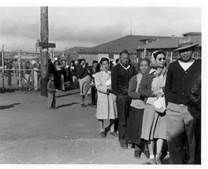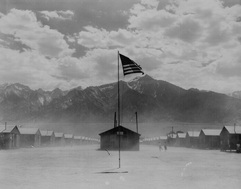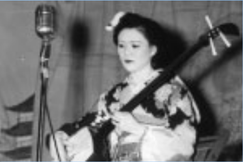"Remember we did not have any water in our rooms. We just had one light bulb and a small stove. We had to get dressed and go to the middle of the block to use the toilet, wash up and take showers. Usually there were people waiting in lines. After you brushed your teeth and cleaned up, you had to go to a separate building for breakfast, lunch, and dinner. They had two sessions. If you were late or forgot your ticket, you could not eat. We stood in line for the food, which was served on metal trays, and we sat at long wooden tables..."
- Marielle Tsukamoto, Internment Camp Survivor
Interment Camps

When the Japanese attacked Pearl Harbor in 1941, the U.S. government took action by forcibly removing people of Japanese ancestry living on the West Coast from their homes. Some 120,000 men, women and children were placed in internment camps, "prison camps for the confinement of enemy aliens, prisoners of war and political prisoners" (dictionary.com) for the duration of World War II.
living conditions

Living conditions in the camps were rather difficult. Many of these camps were located in deserts were the temperatures where either freezing or scorching. There was no privacy or freedom in the camps; entire families were moved into barracks were they shared a single room. The internees were fed inadequately and health services were mediocre at best. Children were forced to go to school but the teaching was usually left to a member of the community for no pay. Due to these unbearable conditions, many social clubs formed.

